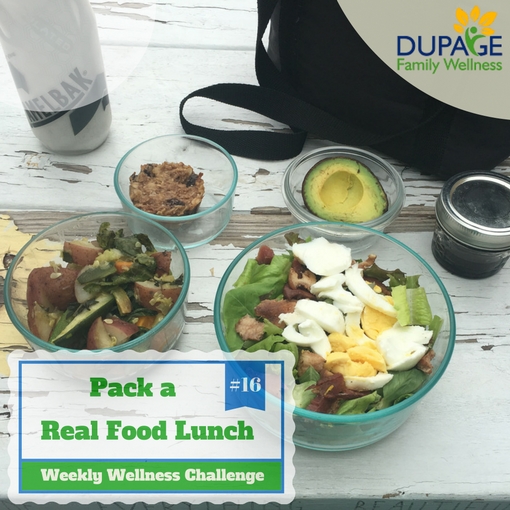 Re-usable water bottle and lunch box that contains salad (with hard boiled egg, bacon, cucumber, tomato, and avocado), container of homemade vinaigrette dressing, hash with potatoes, zucchini, onions and kale, and a homemade chocolate chip muffin
Re-usable water bottle and lunch box that contains salad (with hard boiled egg, bacon, cucumber, tomato, and avocado), container of homemade vinaigrette dressing, hash with potatoes, zucchini, onions and kale, and a homemade chocolate chip muffin
Pack a Lunch that Keeps You Full and Focused All Afternoon
This week I was chatting with a teacher friend who said "It's only 3 weeks into the school year, and I'm already tired of my lunch . Help!".
Focus on nutrient-dense, REAL foods!
Fill lunch boxes with quality fats and proteins to maintain energy all afternoon. Resist the temptation to pack typical lunch foods that are refined and processed (i.e. bread, crackers, chips, cookies, pop, juice boxes, candy, etc). These convenient foods might be easy to grab and stick in the lunch box, but the high sugar and carbohydrate levels cause blood sugar to spike after lunch. When it crashes down, it can cause you to lose energy. You will be ready for a nap before the afternoon is over On the other hand, a lunch with fat and protein keeps blood sugar even, making you feel satisfied and engaged all afternoon.
Eat leftover dinner for lunch
Think about lunch when you make a delicious dinner. Make extra, and remind yourself that you'll have a good lunch if you don't eat it all. We put the leftovers into grab-and-go glass containers when cleaning up the dinner. In the morning, just pop the leftovers into your lunch box.
Nutritious lunch box ideas:
- Wrap a nitrate/nitrite-free lunch meat (Applegate Farms) around slices of avocado
- Breadless sandwiches! Check out these ideas for 15 breadless sandwiches: no bread sandwich ideas
- Homemade soup or leftovers in a thermos
- Chicken, tuna, or egg salad made with homemade mayo
- Salad with homemade oil and vinegar or ranch dressing (easy to make from homemade mayo)
- Guacamole with veggies
- Hard-boiled eggs
- Lettuce Wraps
- Handful of nuts
- Unsweetened dried fruit
- Homemade muffins (Freeze well) – These are a few favorites: cornbread muffins and banana muffins
- Good quality cheese, preferably from pastured cows
- Unsweetened, Plain, Full Fat Yogurt or kefir (try making your own yogurt)
- Apple or celery w/ nut butter
- Unsweetened applesauce - This is easy to make: crockpot applesauce
- Beef Jerky (make your own if you have a dehydrator!)
- Smoked salmon
- Homemade fruit snacks
- Coconut bombs
Having trouble imagining how to make these ideas into a lunch. Pick several items and pack them together for a lunch that will keep you satisfied until dinner.
Our favorite real food lunch combinations:
- Leftover dinner and a piece of fruit
- Chicken salad, celery with nut butter, and a few slices of high-quality cheese
- Two Hard boiled eggs, cornbread muffins smeared with real butter, and a mashed avocado (guacamole) with bell pepper slices
- Homemade soup in a thermos with plain yogurt topped with blueberries, nuts, and cinnamon
- Lettuce wraps with ham, cheese, and avocado slices, a handful of nuts with unsweetened dried fruit (easy trail mix), and applesauce
Remember that transitioning to a real food diet may not happen overnight.
If you aren’t ready to make your own mayo and ranch dressing, it's OK! Just keep moving toward eating more real foods and less packaged, processed, corporation-made "food". Many of the “modern convenience foods” that we buy automatically aren’t that difficult to make on your own. The real ingredients that you use at home are much better for you than the ingredients used in the processed foods in the middle aisles of grocery stores!
A couple of tips to help:
• Set aside a couple of hours each week to prep lunch items (i.e. cut veggies, make a big batch of soup or chicken salad, make and freeze muffins, etc) will make it easy when trying to get everyone out the door in the morning!
• If you have kids, encourage them to help choose, make, and pack their own lunch!
Your challenge this week is to try some of these ideas to make yourself a real food lunch. Let us know how it goes on Facebook.
Joelle Kurczodyna, NTP
Our Two Favorite Techniques for Cutting Vegetables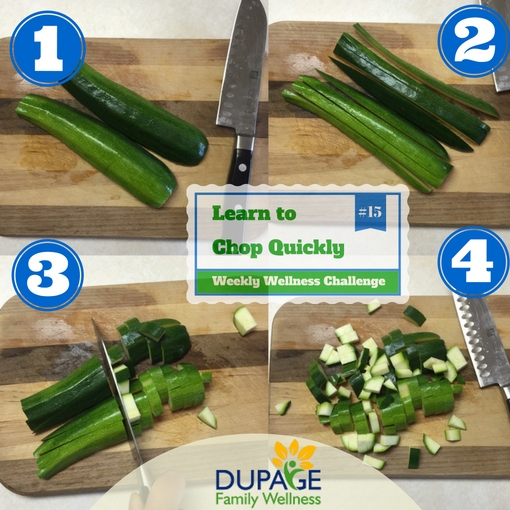
We realize that eating a real, whole food diet, void of convenience processed stuff, takes some time. Yes, it is easier to unwrap a pre-made pan of lasagna than it is to make it from scratch. Remember that the health benefits of eating real food far outweigh the time saved by the convenience of their processed counterparts. I love this short video by author and journalist, Michael Pollan that explains why homemade is better than corporation made.
Fruits and vegetables are important ingredients in most real food recipes. Learning to cut quickly is a key skill.
Chop or Dice Vegetables Quickly by Hand
Learning to chop veggies was a game changer. When I first started to eat more vegetables (usually 8+ servings a day), I was a SLOW chopper, so making a meal took forever. Once I learned this simple trick, chopping was so much faster. Follow these easy steps to chop any circular vegetable (onion, zucchini, carrot, eggplant, mushroom, etc):
- Make your first cut a cut in half long ways. and place the 2 flat sides down. Then the food doesn't roll away from you!
- Make quick slices in one direction (lenthwise).
- Slice in the other direction, across all the strips, as thin or thick as you need.
- Voila! You you have chopped or diced veggies.
Use a good sharp chopping knife! Don't be afraid of the big knife like the one pictured here. It makes the job easier! The more you chop, the faster you get!
Shred or Slice in the Food Processor
Dusting off the food processor might feel like a lot of work, but this tool can save you time. This is especially true when you are bulk cooking. Yesterday, I made a zucchini and eggplant lasagna. Using the slicer attachment, I had the veggies uniformly sliced in no time. I then switched to the shredder attachment. In less than 2 minutes, I shredded cauliflower into “cauli-rice” to go in a stir fry for another meal. This also works well for slicing vegetables to roast or shredding vegetables for many recipes, including egg casseroles.
Weekly Wellness Challenge
This week we challenge you to think about your chopping and make changes if necessary. Are you using the right knife? Are there any tools like a food processor that could make the job easier? Don't let the time it takes to prepare "real food" stop you from eating healthy! Try out these tips and let us know how it goes! Any other fruits or veggies you struggle to chop? Chat with us on facebook, and we'll try to come up with a tip for you!
- Dr. Jamie and Joelle
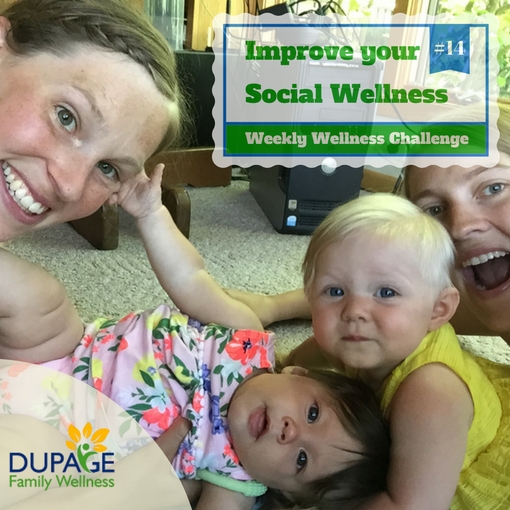
A few weeks ago, we published an article about living to 100. I wanted to emphasize the importance of community and relationships discussed in this article. It is obvious to most of us that eating healthy and moving our bodies is important, but most of us don’t think about how important meaningful relationships are to our health. Did you know that having strong social connections has been linked to motor skill retention, cancer survival, increased immune function, memory preservation, and longevity? Social isolation on the other hand has been linked to increased risk for heart disease and Alzheimer’s disease. Check out this article for links to the research studies on everything I just mentioned!
This week- I challenge you to work on your social wellness! We often get so stuck in our daily routines that we don’t take time to reach out to new people around us, or to deepen our relationships with friends and family.
Here are a few ideas for you to increase your social wellness this week:
1) Call an friend that you haven’t spoken to in a while just to say hi and see what is going on in their life
2) Start a weekly dinner with friends or family. Joelle told me recently that her and her husband are planning a Friday night dinner each week and inviting different friends over to join them.
3) When you are out and about, strike up a conversation with people around you. I know that it is easier to sink into the comfort of your smart phone, but you never know what sorts of interesting people you could meet!
4) Be more social, and use less social media! Ever seen a group of people out to dinner all sitting there staring at their phones? It happens all the time- try putting it away and connecting!
5) Join a group. If you are feeling like your social circle needs some beefing up- try joining something you are passionate about to meet like-minded people. This could be a church, a gardening club, a card group, a fitness class, a sports team, or a volunteer group.
6) Once you join a group- make sure you participate! So many people are “members” of various groups, but only go on occasion. You will form much deeper relationships by interacting with the group more often.
7) Meet someone for a walk! Not only will this get you moving, but if gives you a good opportunity to chat with someone!
So this week I challenge you to try one or two of the suggestions on the list to improve your “social wellness.” Remember, when it comes to relationships with those around us, it isn’t a contest to see who can have the most relationships, but rather how deep and meaningful those relationships are.
If you have more ideas on what you do to improve your social wellness, I’d love to hear them! Chat with us on our facebook page!
-Dr. Jamie Thomure
Our challenge this week seems simple, but might take some creativity to figure out how to add more lifting into your life!
The most important takeaway this week is to re-frame the way you think about lifting things. Once again, we are going to think about what our ancestors used to do. There are so many modern day conveniences that allow us to avoid lifting anything. I encourage you to be conscious of these conveniences and when possible avoid them so that you use your muscles actively throughout the day!
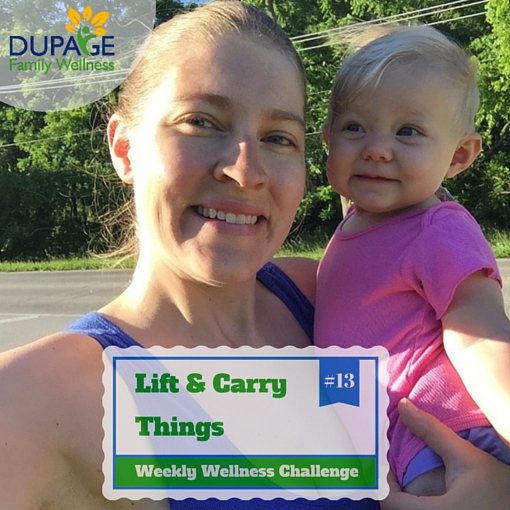
Until a few weeks ago, I never really thought about any of this. Like most people in our country, I would have told you that if you want to lift things, go to the gym. I recently heard a story about having a beach ready body that really resonated with me. A beach body should not be one that simply looks good in a swim suit. A beach ready body is one that is "functional" at the beach. It is a body that if someone were struggling out in the waves, could run, swim, and pick up and carry the struggling person to safety. Often by default if you can do these things well, you probably also look good in the swimsuit, but that is an added bonus.
So what is the best way to get this “functional” beach body? Carry things, move your body, keep your muscles in your body active and engaged as much as possible.
Step 1) Move more- we already talked about this a few weeks ago- so I’ll link back to that article
Step 2) Carry things while you move!
One of the great things about carrying things while you move your body is that you will naturally shift constantly activating all sorts of different muscle groups. If you go to a gym and do a bicep curl machine for example, you work 1 muscle in 1 plane. This doesn’t translate very well to real life movement since there aren’t many situations in which you only have to control something that you lift in one direction with one muscle group. If you take a walk while carrying something you work your whole upper body in all 3 planes!
Lifting/carrying things doesn’t just mean objects- this can mean lifting your body as well. Throughout the course of the day, your muscles will be active a much higher percentage of the time if you are moving, walking, or even sitting unsupported (aka not sinking into a couch or Lazyboy where all of your mucles can just turn off). By sitting on the floor or a stool, you will constantly be shifting your body and keeping your core engaged!
So now that I’ve got you thinking a little bit differently about lifting things and keeping your muscles engaged throughout the day- what are some ways to do this?
- Carrying food- bring your own bags to the grocery store, and carry your food instead of using a cart
- Carrying children- I have been going for walks carrying my 20 pound baby instead of pushing her in a stroller. This way I get an upper body workout- and she does too! In the stroller, she can just turn off all of her muscles instead of supporting her head and torso.
- Carrying water- got a garden? Try watering manually instead of using a hose or a sprinkler
- Carrying supplies on your hike. If you are going for a walk- grab a sack or a pillow case and throw your water and snacks in there. While this is slightly less comfortable than a backpack, carrying it will involve constantly shifting positions and arms which allows different muscle groups to activate! At stopping points, you can swing your sack like a homemade kettle bell!
- Lift your body by doing something like rock climbing, or even playing on the monkey bars at a local park!
- Keep your muscles engaged by standing, sitting on the floor, or sitting in a backless chair/stool instead of sinking into a comfy couch.
- If you have a desk job, try a standing desk at work
- Laundry- lifting/carrying laundry baskets/clothes can be a great workout!
- Cleaning- instead of using a device like a vacuum or a broom, get down on the floor to clean floors
- Go swimming! This is a great way to engage muscles throughout your body (and important if you want that beach body ready that is able to rescue the drowning swimmer!)
What about the gym?
I am not trying to tell you not to go to the gym. I think that this can be a great place to activate your muscles. There are 2 things that worry me about the gym. First of all, I want to shift your thinking from sleeping/sitting 23+ hours a day and moving only during that 30-60 min gym session. I think that movement and muscle engagement should be something we are striving to do as much as possible while we are awake! My second concern about the gym is that people often do exercises that don’t translate well into real life movements. I want you to do movements that mimic things you have to do in real life- not simply getting on an elliptical machine or doing weight machines that isolate one muscle group at a time in one plane. The gym is a great addition to an active lifestyle, but should not be your only activity throughout the day!
So there you have it! I hope you are starting to change the way you think about movement and activity throughout the day. This week try to use at least one of our suggestions to “lift things”- including your own body more often! Let us know how it goes on our facebook page!!
What simple lifestyle change can help you sleep better, see better, and feel happier?
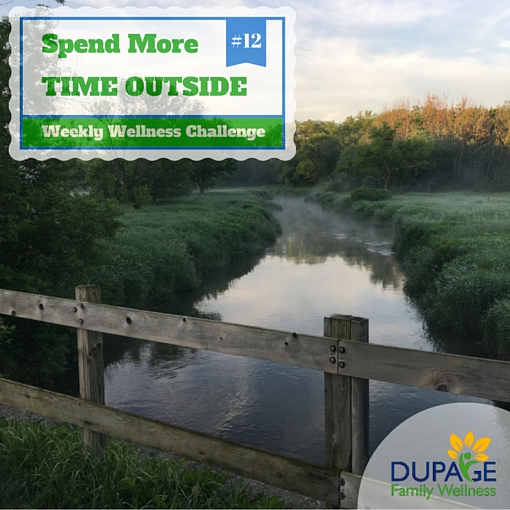 Can you guess the answer? It is spending more time outside! Keep reading to learn why.
Can you guess the answer? It is spending more time outside! Keep reading to learn why.
In Dr. Jamie’s recent post titled "Move More - Move Better", I noticed that her suggestions (walking, hiking, gardening, etc) not only were to move, but to move OUTSIDE.
In general, the current generation spends less time outside than previous generations. This is one of many factors contributing to the decline of health in modern people.
How Does Being Outside Affect Your Health?
Sleep
Think about days where you are outside most of the day. You may have worked hard hiking in the woods or relaxed at the beach with friends. Either way, at the end of the day, you felt tired and probably had a great night’s sleep. This correlation between a good night’s sleep after being outside all day is not a coincidence. Our body’s circadian rhythms are how our bodies know what time it is. They let the body know when it’s time to wake up and when it’s time to sleep.
The most important factor controlling circadian rhythms is exposure to light. The natural light from outside is different from indoor light. To properly set the rhythms of your body, you need to spend time in natural light during the day and avoid unnatural light at night. By doing so, your body will naturally fall into the rhythm of nature and be ready to awake when the sun rises and be winding down when the sun sets. This provides the best opportunity for quality sleep.
I can personally attest to these improvements. My goal has been to be outside with my 5 month old as much as possible when she is awake. Once we developed this habit, her body almost immediately began a very regular sleep cycle and she’s been easily going to bed every night and sleeping great.
Myopia (Nearsightedness)
When I was a kid, only a few of my classmates wore glasses. Over the last couple of decades there has been a huge increase in myopia, specifically in industrialized countries. In biomechanist, Katy Bowman’s book Move Your DNA, she says
“Research shows that cultures historically without books show an increase in nearsightedness once reading or other hallmarks of a “civilized” environment (like night-lighting) are introduced. But more recent research specifically looking at reading shows that time spend outdoors might be the factor worth looking at instead.”
She goes one to talk about how the loads on your eyes changes depending on how far you are looking. If you are inside most of the day, even if you aren’t looking at a book or screen, you only look 20-30 feet at most. This close looking it causes the ciliary muscles in your eyes to contract. If you spend too much time looking at short distance, it does not give your eyes the chance to create a different load by looking far distances. The action of looking far away causes the relaxation of these tense eye muscles. Read more on myopia and the ciliary muscles.
General Well Being
In addition to these two specific examples, there are several studies that link being outside in nature to general overall health. Being in nature has been found to restore your focus, help you relax, be great for your brain, and increase overall feelings of happiness.
What are some practical ways to add more outdoor time to your life?
- Eat outside! You have to eat anyways, so why not eat outside. It can be a quiet breakfast or cup of coffee on the deck in the morning, lunch at a park with a coworker, or a family dinner outside.
- Move outside! Follow the examples in Dr. Jamie's previous post. Move More - Move Better. Instead of hitting the gym, spend more time moving outside in nature.
- Get a dog. I realize this might not be for everyone, but since getting our dog a year and a half ago we go on so many more walks out of necessity for him and overall enjoyment for the whole family!
- Meet a friend outside! Instead of meeting at the local coffee shop, find a park outside to chat, or take a walk instead.
- Take your phone calls outside! When I have to make one of those phone calls where I expect to be on hold for many minutes, I try to make the call while going for a walk. It makes the wait more enjoyable!
If you start paying attention to how much time you spend inside, you might be surprised. Use your ingenuity to figure out ways to get yourself outside.
Your challenge for the week: Try one or more of these ideas to add more outdoor time to your life.
Joelle Kurczodyna, NTP
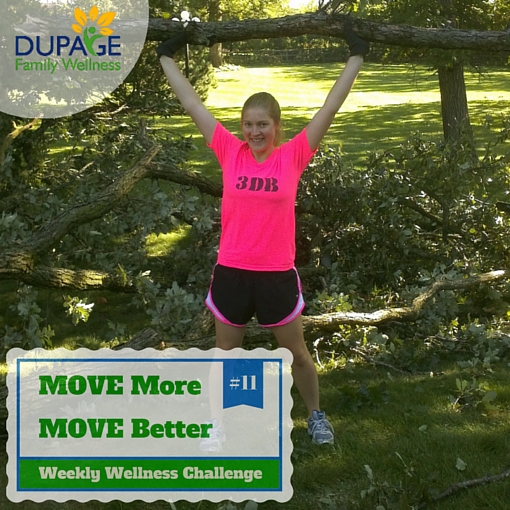 Move More - Move Better
Move More - Move Better
I saw an Instagram post earlier this week (follow me @docjthomure ) that resonated with me. The poster was Dallas Hartwig, one of the creators of the Whole 30 program where you eat real unprocessed foods for 30 days. Dallas discussed his movement while growing up. It included working in the family garden, traveling to the mountains to hike, mountain biking, canoeing, and swimming. His life was full of healthy movement, in spite of the fact that it did not include any planned or structured "exercise".
Dallas pointed out that “health is not dependent on doing tons of hard, structured exercise, and in a lot of cases hard training actually DECREASES health.” This idea has been trending in other research as well.
Many lean, fit, and muscular people have health problems that include gut issues, insomnia, fatigue, anxiety, chronic inflammation, thyroid problems, or depression. These people chase “fitness” with an intense structured exercise regimen, but it often leads to decreased health. I would rather be "healthy", meaning free of disease or injury, than have 6 pack abs that look good in the mirror, but are accompanied by underlying health conditions.
The Copenhagen City Heart Study explores the relationship between jogging and all cause mortality. They found that light and moderate joggers had lower mortality than sedentary people, but strenuous joggers had the same mortality rate as sedentary non-joggers.
Movement is an important component of overall health. People that move more throughout the day in functional ways will be healthier than those that go to the gym and beat themselves up with a repetitive workout for 45 minutes (especially if their one bout of movement is sandwiched between a desk job and an evening in front of the TV). These days, a desk job can be unavoidable. If this is your reality, walk, do squats, take the stairs, get a standing desk, and leave your desk as much as possible throughout your work day.
What are healthy functional movements?
Move more like your ancestors used to move! Just like we've discussed eating like our ancestors, we should also move like them. Functional movements will you help you to improve strength, improve mobility, and improve stability. For example:
- Walk
- Pick up something heavy and carry it
- Plant a garden and tend to it (squat)
- Climb a tree
- Build something
- Chase something
- Swim
- Paddle a boat
- Ride a bicycle
- Dance
- Play with your kids- or just act like a kid!
While this advice may seem unconventional, it is your challenge this week. Add healthy functional movement to your life each day. If you spend as much time moving as our ancestors used to (and by default less time at a desk/on a computer/watching TV, etc.) - it will lead to better health!
Dr, Jamie Thomure
 Re-usable water bottle and lunch box that contains salad (with hard boiled egg, bacon, cucumber, tomato, and avocado), container of homemade vinaigrette dressing, hash with potatoes, zucchini, onions and kale, and a homemade chocolate chip muffin
Re-usable water bottle and lunch box that contains salad (with hard boiled egg, bacon, cucumber, tomato, and avocado), container of homemade vinaigrette dressing, hash with potatoes, zucchini, onions and kale, and a homemade chocolate chip muffin




 Can you guess the answer? It is spending more time outside! Keep reading to learn why.
Can you guess the answer? It is spending more time outside! Keep reading to learn why. Move More - Move Better
Move More - Move Better